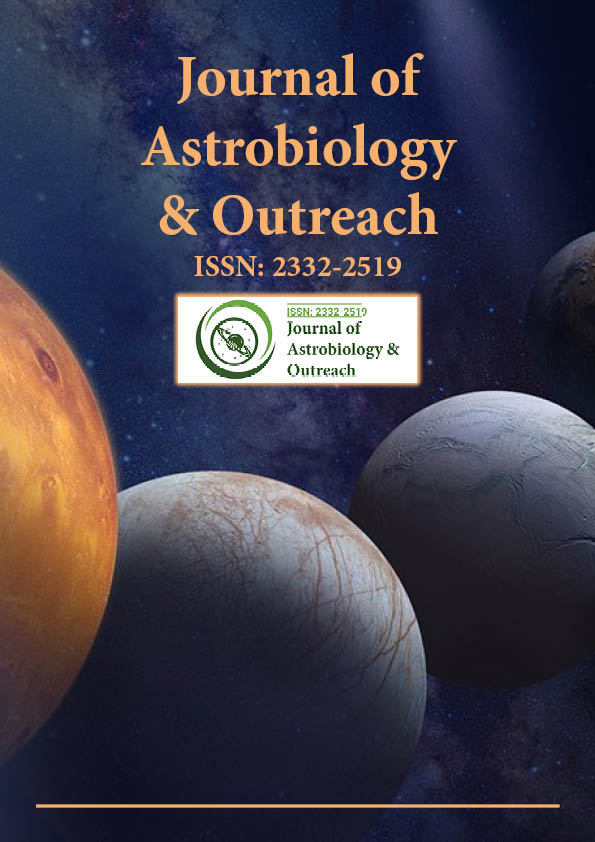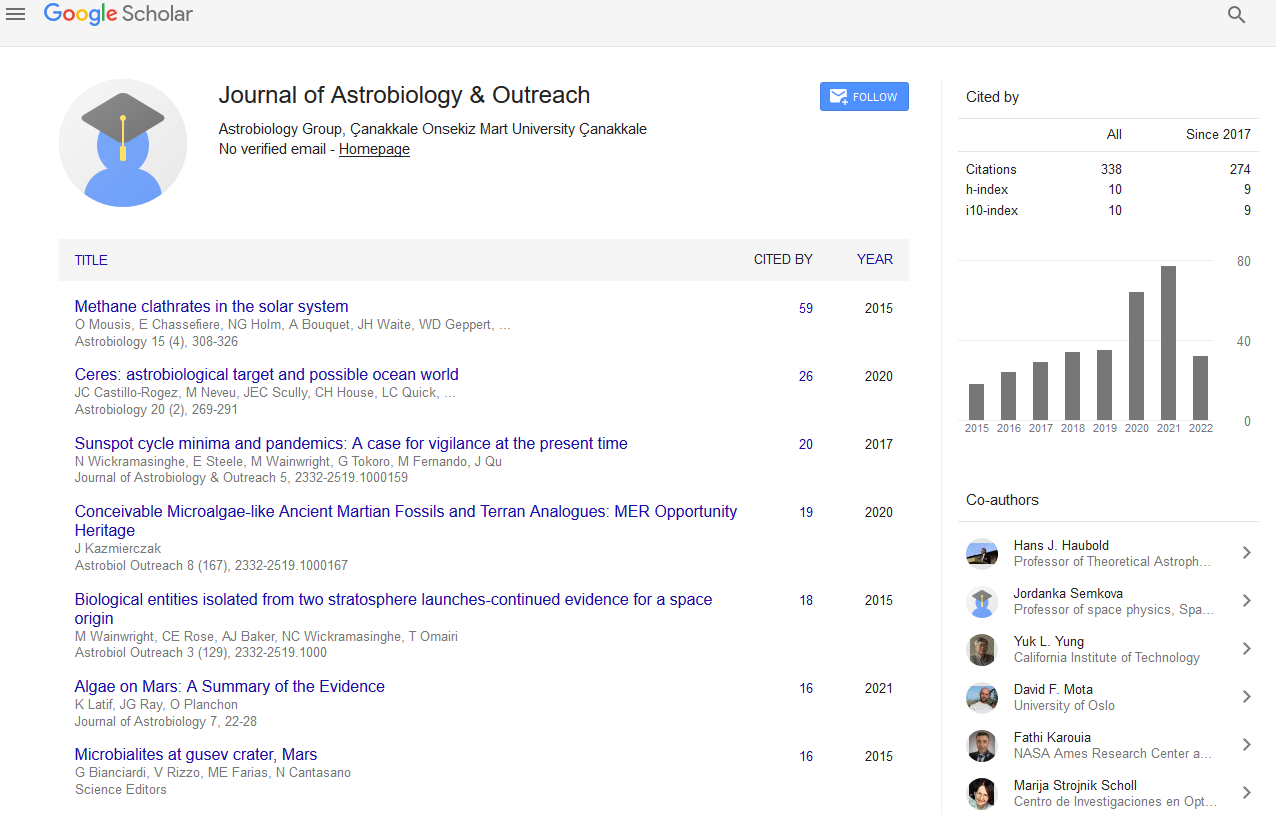Indexed In
- Open J Gate
- Academic Keys
- JournalTOCs
- RefSeek
- Hamdard University
- EBSCO A-Z
- OCLC- WorldCat
- Google Scholar
Useful Links
Share This Page
Journal Flyer

Open Access Journals
- Agri and Aquaculture
- Biochemistry
- Bioinformatics & Systems Biology
- Business & Management
- Chemistry
- Clinical Sciences
- Engineering
- Food & Nutrition
- General Science
- Genetics & Molecular Biology
- Immunology & Microbiology
- Medical Sciences
- Neuroscience & Psychology
- Nursing & Health Care
- Pharmaceutical Sciences
Perspective - (2025) Volume 13, Issue 1
Orbital Evolution of Meteorites and the Search for Their Parent Asteroids
Isabella Starling*Received: 19-Feb-2025, Manuscript No. JAO-25-28772; Editor assigned: 21-Feb-2025, Pre QC No. JAO-25-28772 (PQ); Reviewed: 07-Mar-2025, QC No. JAO-25-28772; Revised: 14-Mar-2025, Manuscript No. JAO-25-28772 (R); Published: 21-Mar-2025, DOI: 10.35248/2332-2519.25.13.373
Description
Understanding the orbital evolution of meteorites and identifying their parent asteroids represents a compelling challenge in planetary science. Instrumentally observed meteorite falls provide a rare and scientifically valuable opportunity, as they allow for precise orbital reconstruction prior to atmospheric entry. With orbital elements accurately determined for 40 such meteorites, researchers have been able to backtrack their trajectories in the solar system and evaluate their potential source regions among the asteroid population. This growing dataset provides critical insights into the dynamical pathways that deliver material from the asteroid belt to Earth and the complex gravitational and thermal processes that form those pathways over time.
The orbital elements of meteorites such as semi-major axis, eccentricity, inclination and perihelion distance serve as fingerprints of their past journeys. By integrating these orbits backward in time using numerical simulations, scientists can trace how non-gravitational forces like the Yarkovsky effect and planetary encounters gradually modified their trajectories. One of the most striking patterns that have emerged is the clustering of pre-atmospheric orbits near powerful mean-motion and secular resonances with Jupiter and Mars. These resonances act as escape hatches from the main belt, injecting small bodies onto Earth-crossing orbits. For example, the 3:1 resonance with Jupiter and the ν6 secular resonance are commonly associated with the delivery of ordinary chondrites—meteorites that dominate the observed fall statistics.
Despite the inherent uncertainties in long-term orbital integration due to chaotic perturbations and incomplete knowledge of past physical conditions, statistical approaches have allowed researchers to associate certain meteorites with plausible source regions. For example, H, L and LL chondrites often exhibit orbital parameters consistent with origins in the inner main belt, particularly from the Flora and Eunomia asteroid families. On the other hand, carbonaceous chondrites with lower entry velocities tend to trace back to outer belt asteroids or to the region associated with the Eos family. These connections are reinforced by spectroscopic similarities between meteorites and asteroids, although differences in space weathering and regolith processes still complicate one-to-one matching.
What remains particularly intriguing is the small subset of meteorites that follow more eccentric or higher inclination orbits than typical main belt delivery paths suggest. These anomalies raise the possibility of dynamically evolved parent bodies, such as near-Earth asteroids that may have undergone collisional fragmentation or thermal spin-up prior to Earth encounter. In some cases, the pre-impact orbit is consistent with known Apollo or Amor asteroids, suggesting the existence of metastable reservoirs for meteoroids in near-Earth space. The question then becomes whether these objects are merely waypoints in a longer delivery process or whether they represent true end-stage progenitors of certain meteorites.
Efforts to identify specific parent asteroids remain challenging, largely due to the vast number of potential candidates and the limitations in backward orbital modeling. However, machine learning techniques and improved statistical models are now being applied to bridge compositional data, orbital dynamics and collisional histories. With more instrumentally recorded fireballs and refined trajectory determination methods, the chances of making firm connections between meteorites and specific parent bodies are improving. When combined with global databases such as the Fireball and Bolide Reports and asteroid spectral libraries, this integrated approach enhances our understanding of the asteroid-meteorite linkage.
The study of orbital evolution also offers implications for planetary defense. By analyzing how certain orbits evolve over time under solar and planetary perturbations, we gain a better understanding of impact probabilities and potential warning times. Many small bodies share similar orbital characteristics with known meteorite-producing events, emphasizing the importance of monitoring Earth-crossing objects not only for scientific purposes but also for hazard mitigation.
In conclusion, the integration of orbital analysis with spectral, compositional and observational data is transforming our understanding of meteorite origins. The detailed tracking of 40 instrumentally observed meteorites stands as a testament to the progress being made in connecting Earth-bound samples to their celestial progenitors. As datasets grow and modeling techniques advance, a more complete and dynamic portrait of the solar system’s evolutionary processes continues to emerge—one that not only deepens scientific understanding but also strengthens our preparedness for future encounters with near-Earth objects.
Citation: Starling I (2025). Orbital Evolution of Meteorites and the Search for Their Parent Asteroids. J Astrobiol Outreach. 13:373.
Copyright: © 2025 Starling I. This is an open-access article distributed under the terms of the Creative Commons Attribution License, which permits unrestricted use, distribution, and reproduction in any medium, provided the original author and source are credited.

